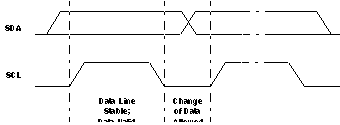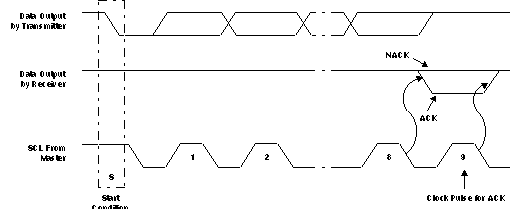JAJSLF6I October 2005 – June 2022 PCA9546A
PRODUCTION DATA
- 1 特長
- 2 アプリケーション
- 3 概要
- 4 Revision History
- 5 Pin Configuration and Functions
- 6 Specifications
- 7 Parameter Measurement Information
- 8 Detailed Description
- 9 Application Information Disclaimer
- 10Power Supply Recommendations
- 11Layout
- 12Device and Documentation Support
- 13Mechanical, Packaging, and Orderable Information
8.5.1 I2C Interface
The I2C bus is for two-way two-line communication between different ICs or modules. The two lines are a serial data line (SDA) and a serial clock line (SCL). Both lines must be connected to a positive supply via a pull-up resistor when connected to the output stages of a device. Data transfer can be initiated only when the bus is not busy.
One data bit is transferred during each clock pulse. The data on the SDA line must remain stable during the high period of the clock pulse, as changes in the data line at this time are interpreted as control signals (see Figure 8-1).
 Figure 8-1 Bit Transfer
Figure 8-1 Bit TransferBoth data and clock lines remain high when the bus is not busy. A high-to-low transition of the data line while the clock is high is defined as the start condition (S). A low-to-high transition of the data line while the clock is high is defined as the stop condition (P) (see Figure 8-2).
 Figure 8-2 Definition of Start and Stop Conditions
Figure 8-2 Definition of Start and Stop ConditionsA device generating a message is a transmitter; a device receiving is the receiver. The device that controls the message is the master, and the devices that are controlled by the master are the slaves (see Figure 8-3).
 Figure 8-3 System Configuration
Figure 8-3 System ConfigurationThe number of data bytes transferred between the start and the stop conditions from transmitter to receiver is not limited. Each byte of eight bits is followed by one acknowledge (ACK) bit. The transmitter must release the SDA line before the receiver can send an ACK bit.
When a slave receiver is addressed, it must generate an ACK after the reception of each byte. Also, a master must generate an ACK after the reception of each byte that has been clocked out of the slave transmitter. The device that acknowledges must pull down the SDA line during the ACK clock pulse so that the SDA line is stable low during the high pulse of the ACK-related clock period (see Figure 8-4). Setup and hold times must be taken into account.
 Figure 8-4 Acknowledgment on the I2C Bus
Figure 8-4 Acknowledgment on the I2C BusData is transmitted to the PCA9546A control register using the write mode shown in Figure 8-5.
 Figure 8-5 Write Control Register
Figure 8-5 Write Control RegisterData is read from the PCA9546A control register using the read mode shown in Figure 8-6.
 Figure 8-6 Read Control Register
Figure 8-6 Read Control Register